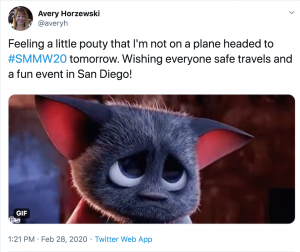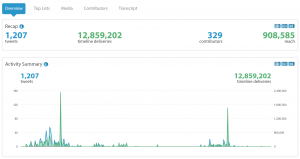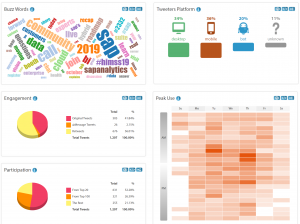6 Tips for Using Event Hashtags and Why They Matter
6 Tips for Using Event Hashtags and Why They Matter
A while back, #SMMW20 took place in San Diego. I had to bow out at the last moment due to a broken hand. ☹ I went to tweet about missing the event and checked the website to confirm the hashtag (yeah, I know I should remember) and couldn’t find it anywhere. Thus, the genesis for this post.
It’s a pet peeve of mine. If you’re hosting an event, and if you have a hashtag, promote it. Everywhere. (See the first tip below).
So many big events have hashtags, and yet most make you work to figure out what it is. (Insert a Gibbs- smack.) But really, it doesn’t matter if it’s a webinar series, a regular live stream, an X(Twitter) chat, a virtual event, or an in-person event, if you got it (a hashtag), flaunt it. It’s that simple.


Why event hashtags are important
One word: Conversation. And you want that conversation starting before they hit your show floor or click through to your webinar, live stream, X chat, etc.
Okay, two more words: Sentiment and Analytics. But really, it’s about the conversation.
You want people talking about your event, and a hashtag:
- Makes it easy for everyone interested to see and join in that conversation—this is even more important for virtual events, where there is no show floor chatter
- Creates excitement for and awareness about the event before it happens
- Allows attendees to learn from sessions they miss because they can’t clone themselves
- Gives a flavor of the activities to people who can’t be there
- Extends the life of your event beyond the hours or days it runs
The list goes on.
6 tips for getting the most out of your event hashtag
- Put it everywhere! It should be prominent on the event website, related cover images, and any event communication. And link to the tag in the body copy of any online communication (like in a blog), so readers can quickly click off to see the conversation.
- Keep it short and simple. Yes, character count is less of an issue these days, but that doesn’t mean long hashtags are okay. A short-and-sweet hashtag is easier to remember and to use. If you have a long event name, think abbreviation.
- Make it unique. It helps make it easy to remember and ensure the tag isn’t confused with another hashtag. And, really, you want one that’s not already in use.
- Don’t date it. Unless you must, that is. Followers will inevitably use multiple versions. Is it #SMMW20 or #SMMW2020, for example. Sometimes, though, it can’t be helped. Just know mistakes can happen if you add the date, which makes putting it everywhere even more important.
- Have a display wall(s). You can even do this with virtual events, depending on the software you use. For example, Adobe Connect allows you to bring X and Instagram in with its Social Stream Pod app, and Livestream offers social media integration.
- Track it. There are lots of tools for hashtag analytics. Find one you like and use it (list at the end). I like Hashtracking. It is affordable, gives loads of analytics, and has an option for custom streaming walls. Hand in hand with analytics is sentiment. Having a hashtag allows you to monitor the sentiment around your event.
Using event hashtags – some great examples:
A great example of making the most out of your event hashtag is Madalyn Sklar’s #TwitterSmarter. Yes, it’s on the long side of what you want, but it’s unique, easy to remember, and she’s a master at putting it everywhere. She uses it for her podcast and X chat, and keeps the conversation going in between events with related content.

ISTE does a good job with tips 1 – 3, as well, with #ISTE20. It’s on their various social channels, they include it imagery (like the Instagram post below), and it’s on the ISTE20 event home page in two places (above the fold in the hero image and next to their social media channels).

How to create an event hashtag
First, to make it clear, no one can “own” a hashtag. Anyone, anywhere can use “your” hashtag. That’s why being unique is helpful and why you need to do some homework before selecting a hashtag.
Since social media is a big, loud party, a lot of hashtags are already in use, I like to:
- Brainstorm a short list of hashtags that might work
- Check availability by searching for each tag on X and Instagram directly or use a tool like https://hashtagify.me/
I like brainstorming a short list vs. coming up with one, seeing if it’s available, and then coming up with another one when it’s not, and on and on and on. It’s easier to come up with a list and then search (for me at least).
Once you have a tag that’s available, start using it. Everywhere. See tip #1 above.
Tools for hashtag analytics
There are a lot of tools that you can use, but I really like Hashtracking. It gives you a variety of hashtag-related data, including contributors, top lists (most popular, most retweets, most reach, etc.), and a transcript, for both X and Instagram, and the price is reasonable.
Below are a few sample data elements from Hashtracking, along with a few more tools you can explore (although there are even more than what I list here):

Hashtracking overview dashboard part 1

Hashtracking overview dashboard part 2
Speaking of hashtags and virtual events, check out our #AventiLive chats.






